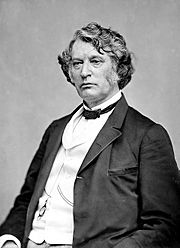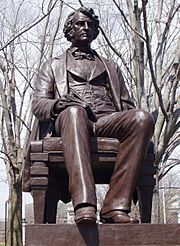Charles Sumner facts for kids
Quick facts for kids
Charles Sumner
|
|
|---|---|
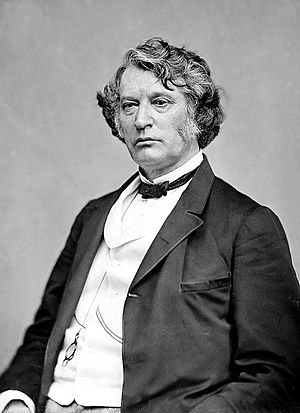 |
|
| Dean of the United States Senate | |
| In office March 4, 1869 – March 11, 1874 |
|
| Preceded by | Benjamin Wade |
| Succeeded by | Zachariah Chandler |
| Chair of the Senate Foreign Relations Committee | |
| In office March 4, 1861 – March 4, 1871 |
|
| Preceded by | James M. Mason |
| Succeeded by | Simon Cameron |
| United States Senator from Massachusetts |
|
| In office April 25, 1851 – March 11, 1874 |
|
| Preceded by | Robert Rantoul Jr. |
| Succeeded by | William B. Washburn |
| Personal details | |
| Born | January 6, 1811 Boston, Massachusetts, U.S. |
| Died | March 11, 1874 (aged 63) Washington, D.C., U.S. |
| Resting place | Mount Auburn Cemetery |
| Political party | Whig (1840–1848) Free Soil (1848–1854) Republican (1854–1870, 1872–1874) Liberal Republican (1870–1872) |
| Spouse |
Alice Hooper
(m. 1866; div. 1873) |
| Relatives | Sumner family |
| Education | Harvard University (AB, LLB) |
| Signature | |
Charles Sumner (January 6, 1811 – March 11, 1874) was an important American politician. He served as a United States Senator for Massachusetts. Sumner was a strong speaker and a leader in the fight against slavery. He also led the Radical Republicans in the U.S. Senate during the American Civil War.
After the war, during the Reconstruction Era, Sumner worked to protect the rights of freedmen (formerly enslaved people). He wanted to make sure they had equal rights. He also tried to limit the power of former Confederates. Sumner had disagreements with President Ulysses Grant over the control of Santo Domingo. This led to him losing some power in the Senate.
Sumner changed political parties several times. He was best known as a member of the Republican Party. He worked hard to end the influence of Southern slave owners. These owners wanted to keep and expand slavery. On May 22, 1856, a congressman named Preston Brooks attacked Sumner. This happened on the Senate floor after Sumner gave an anti-slavery speech. The attack left Sumner badly hurt. He could not return to the Senate for several years. Massachusetts showed its support by re-electing him and leaving his Senate desk empty. This event showed how divided and angry the country was before the Civil War.
During the Civil War, Sumner was a leader of the Radical Republican group. They believed President Abraham Lincoln was too slow in ending slavery. Sumner focused on foreign affairs. He worked with Lincoln to keep Britain and France from helping the Confederacy. After the war, Sumner continued to fight for equal rights for freedmen. He believed that all people should have a say in their government. He also wanted to stop former Confederates from regaining power. Sumner worked with House leader Thaddeus Stevens to push for strong Reconstruction plans. He was against the U.S. taking over the Dominican Republic. This disagreement led to a major conflict with President Grant. Sumner lost his position as head of the Foreign Relations Committee. He died while still in office.
Contents
Early Life and Learning
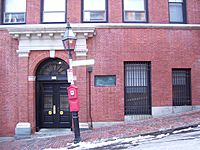
Charles Sumner was born in Boston on January 6, 1811. His father, Charles Pinckney Sumner, was a lawyer. He was against slavery and supported schools where all races learned together. His father believed that formerly enslaved people should be treated equally.
Sumner's family was not rich. His father became the Sheriff of Suffolk County in 1825. This helped the family afford better education for their children. Charles Sumner went to the Boston Latin School. He then attended Harvard College and Harvard Law School. He loved studying law.
After law school, Sumner became a lawyer in Boston. He also taught at Harvard Law School.
Traveling in Europe
In 1837, Sumner traveled to Europe. He visited many countries and learned several languages. He met important leaders and thinkers. In Paris, he noticed that Black people were treated equally. This made him realize that ideas about race were learned, not natural. He decided then to become an abolitionist when he returned home.
He came back to the U.S. in 1840. He continued to practice law and lecture at Harvard.
Early Political Work
Sumner became friends with many important people in Boston. In 1845, he gave a famous speech called "The True Grandeur of Nations." In this speech, he spoke against the Mexican–American War. He called for peace and freedom for all.
Sumner was a tall man, about 6 feet 4 inches. He had a strong, clear voice. His speeches were powerful and full of details. He often quoted from the Bible and ancient texts.
Sumner became active in the anti-slavery movement. In 1845, he argued in a court case called Roberts v. Boston. He challenged the idea of separate schools for Black and white children. He said that segregated schools were unfair and harmful. Sumner lost the case, but Massachusetts ended school segregation in 1855.
Sumner helped create the Free Soil Party. This party was against slavery spreading into new territories. In 1851, Sumner was elected as a U.S. Senator for Massachusetts. This was a big change for Massachusetts politics. His predecessor, Daniel Webster, had supported the Compromise of 1850, which included the Fugitive Slave Act.
Serving in the Senate (1851–1874)
Fighting Slavery in the Senate
Sumner began his Senate term in 1851. He soon became known for his strong anti-slavery views. In 1852, he gave a major speech titled "Freedom National; Slavery Sectional." He attacked the 1850 Fugitive Slave Act. This law forced people to return escaped enslaved individuals. Sumner called the law a violation of the Constitution and a moral wrong. His strong words made him unpopular with senators who supported slavery.
The Attack in the Senate
On May 22, 1856, after Sumner gave a powerful anti-slavery speech, he was attacked. A congressman named Preston Brooks beat him with a cane on the Senate floor. Sumner suffered a serious head injury. He also had nightmares and severe headaches. He was out of the Senate for several years to recover.
Despite his absence, Massachusetts showed its support. They re-elected him in 1856. His empty chair in the Senate became a symbol of free speech and resistance to slavery.
Sumner traveled to Europe for treatment and rest. He slowly recovered and returned to the Senate in 1859. He continued to speak out against slavery. In 1860, he gave a speech called "The Barbarism of Slavery." He argued that slavery was harmful to the South's economy and its people.
Civil War Leadership
When the Civil War began in 1861, Sumner joined the Radical Republicans. This group wanted to end slavery immediately. They also wanted to break the power of Southern plantation owners. Sumner, along with Zachariah Chandler and Benjamin Wade, often met with President Abraham Lincoln. They urged him to make ending slavery the main goal of the war.
Sumner became the head of the Senate Foreign Relations Committee. He worked to get diplomatic recognition for Haiti. Haiti had been independent since 1804 but faced opposition from Southern senators. With Southern senators gone, the U.S. recognized Haiti in 1862.
Ending Slavery
Sumner believed that ending slavery would give the Union a stronger moral standing. This would help prevent Britain from joining the Confederacy. The Radicals passed laws in 1861 and 1862. These laws allowed the Union army to free enslaved people who were used by the Confederate military. On January 1, 1863, President Lincoln issued the Emancipation Proclamation. This declared many enslaved people free.
Sumner argued that the war was a fight between two different ways of life. He believed the South needed to be changed to be more like the North.
The Trent Affair
In November 1861, a U.S. Navy ship stopped a British ship, the Trent. Two Confederate diplomats were on board. The U.S. captured them. Many Americans were happy, but Britain was angry. They sent troops to Canada and prepared their navy.
Sumner believed the capture was wrong. He argued that the diplomats were not "contraband of war" because they were unarmed. He advised Lincoln to release them and apologize. Lincoln reluctantly agreed. This helped prevent a war with Britain.
Reconstruction and Civil Rights
After the Civil War, Sumner became a leading voice for Black Americans. He fought for equal civil and voting rights for freedmen. He believed that all people should have the right to vote and be treated fairly. He also wanted to prevent former Confederates from regaining political power.
Sumner believed that the U.S. Constitution should be read with the Declaration of Independence in mind. He argued that the Southern states, by leaving the Union, had lost their rights as states. He wanted Congress to set strict rules for them to rejoin. He disagreed with President Andrew Johnson's more lenient plans. When Johnson was impeached, Sumner voted to remove him from office.
Sumner was a strong supporter of voting rights for Black Americans. He also pushed for free public schools and land for formerly enslaved people. He saw segregation and slavery as similar evils. He introduced a bill in 1872 to ensure equal treatment in all public places. This bill failed during his lifetime, but it was passed after his death as the Civil Rights Act of 1875.
Sumner also tried to remove the word "white" from laws about who could become a U.S. citizen. He argued that denying citizenship based on race went against American ideals. His efforts to include Chinese immigrants in naturalization laws were unsuccessful at the time.
Alaska Purchase
In 1867, the U.S. negotiated to buy Alaska from Russia for $7.2 million. President Johnson asked Congress to approve the treaty. Sumner, as head of the Foreign Relations Committee, strongly supported the purchase. He gave a long speech describing Alaska's resources and importance. He believed it would help the U.S. grow and prevent British expansion. The treaty passed by just one vote.
Sumner suggested that the new territory be called "Alaska," an Aleutian name meaning "great land." He also pushed for free public education and equal protection for all U.S. citizens in Alaska.
Disagreement with President Grant
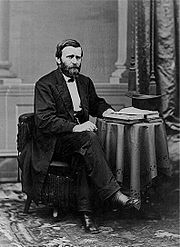
In 1869, President Grant wanted to annex the Dominican Republic (then called Santo Domingo). Grant believed the island's resources would be valuable. He also thought it could be a safe place for Black Americans to move. Grant's private secretary secretly negotiated a treaty.
Sumner was against this annexation. He feared it would lead to American imperialism and threaten the independence of Haiti. He also suspected corruption behind the treaty. As chairman of the Senate Foreign Relations Committee, Sumner spoke out against it. He argued that Grant's use of the U.S. Navy to protect the Dominican Republic was unconstitutional. The Senate voted against the treaty in June 1870.
Grant felt betrayed by Sumner. He retaliated by firing Sumner's friend, John Lothrop Motley, who was the Ambassador to Britain. The relationship between Grant and Sumner became very hostile. In 1871, Grant's supporters in the Senate voted to remove Sumner from his position as head of the Foreign Relations Committee.
Later Years and Death
Sumner became very critical of President Grant. He believed Grant's administration was corrupt. In 1872, he joined the Liberal Republican Party. This party wanted reforms and supported Black suffrage. However, they also called for forgiveness for former Confederates.
Sumner continued to push for civil rights. He believed that true peace with the South required equality for all. He opposed displaying Civil War battle names on U.S. Army flags. He felt this would keep alive bad memories between Americans. This idea was not popular with Union army veterans.
Sumner's health declined. He died of a heart attack at his home in Washington, D.C., on March 11, 1874. He was 63 years old. He was honored by lying in state at the United States Capitol rotunda. He was buried in Mount Auburn Cemetery in Cambridge, Massachusetts.
Marriage
Sumner was single for most of his life. In 1866, he married Alice Mason Hooper. Their marriage was unhappy, and they divorced in 1873.
Memorials
Many places are named after Charles Sumner:
- Sumner Street in Newton Centre, Massachusetts
- Sumner High School (St. Louis) in St. Louis, Missouri. It was the first high school for African Americans west of the Mississippi River.
- Charles Sumner Elementary School in Camden, New Jersey
- Charles Sumner Elementary School in Roslindale, Massachusetts
- Sumner Avenue in Springfield, Massachusetts
- Charles Sumner School and museum in Washington, D.C.
- Sumner Elementary School in Topeka, Kansas. This school played a key role in the 1954 Brown v. Board of Education case.
- Sumner Academy of Arts & Science in Kansas City, Kansas
- Charles Sumner House, Sumner's home in Boston
- Sumner Library in Minneapolis
- Sumner County, Kansas
- Sumner, Iowa
- Sumner, Nebraska
- Sumner, Washington
- Sumner, Oregon
- Avenida Charles Sumner in the Dominican Republic
- Avenue Charles Sumner in Port-au-Prince, Haiti
- SS Charles Sumner, a World War II cargo ship.
Images for kids
-
Senator Sumner and his friend Henry Wadsworth Longfellow, photographed by Gardner in 1863
-
.
Sumner puts head in British lion's mouth—Harper's Weekly, 1872
See also
 In Spanish: Charles Sumner para niños
In Spanish: Charles Sumner para niños



